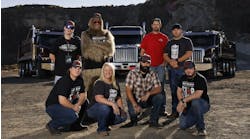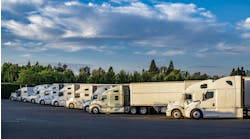This is the first of a two-part story on the best practices involving truck and trailer leasing options. We interviewed people from five companies that lease trucks and/or trailers to the trucking industry with a focus on the small and micro-carrier.
For part one, we interviewed the following industry leaders: Greg Maniscalco, vice president relationship manager with Navistar Capital, division of BMO (Bank of Montreal, Financial Group); Jim Lager, senior vice president of sales, Penske Truck Leasing; and Matt Svancara, executive vice president, Aim Leasing Company.
What are the benefits to a small trucking company in leasing their tractors and/or trailers?
Maniscalco: Cash flow improvement (lease payments typically lower than comparable loan payments) due to inclusion of residual value.
Getting newer equipment more frequently, setting the lease term to match mileage/warranty coverages, and avoiding equipment obsolescence and used-equipment value fluctuations.
Customized payment structures, and the ability to re-invest cash flow savings back into the business.
Lager: The customer gets the full benefit of using the vehicle without the exposure of owning it. We provide a very manageable and consistent cost stream when it comes to equipment. They can utilize Penske’s extensive network of facilities and our highly trained technicians for vehicle maintenance, ultimately leasing to better uptime. Our customers can rely on our company to counsel them through a maze of current and emerging regulations; items like tax reporting, spec optimization, and regulatory compliance. We can also supplement their existing fleet with rentals to correlate with seasonal spikes. So our customers can focus their efforts on their core competencies and do what they do best.
Svancara: The days of the old-school technician diagnosing a truck by ear are gone. Extremely technical components introduced to trucks over the last decade require specialized training and specialized software for diagnosis and repair. TRALA members spend significant time and money to train technicians for each manufacturer and engine to deal with the technical challenges. When we meet with small fleets, they tell us the biggest challenges are training and software. It’s understandable; the economies of scale a leasing firm can bring to the table make all the difference. There is also a significant increase in turnaround time over dealerships.
What are the financial requirements for a small carrier to qualify to lease their equipment?
Maniscalco: It varies by lender. Minimum three to five units in a fleet, and $1 million in annual revenue. Higher limits for insurance are required, and several years in business with comparable payment reporting.
Lager: We look at every company’s situation on an individual basis and know they are unique and have unique needs. Essentially, we look at a company’s ability to pay over the life of the lease, and we work with customers to customize and find a deal that will meet their needs.
Svancara: The good news for small carriers is that leasing companies today offer many unbundled packages for customers to pick and choose the services that best fit their needs. Unbundled leases can help carriers who may have credit issues qualifying for a traditional full-service lease or outright purchase.
Typically, a leasing company would ask for financials and credit references to qualify a customer; however, leasing helps lessen monthly payments with residual values and longer terms than a typical bank loan. Used rental equipment is also an option, and many times a leasing company can work with a deposit or security.
What are the different types of leases that are available?
Maniscalco: Fair Market Value Lease (FMV). A standard FMV is a true, tax-oriented lease in which the lessor retains all benefits of ownership. The FMV reflects the lessee’s options at lease expiration to purchase the equipment at end of term: 1) purchase for FMV; 2) continue lease at current monthly rental amount; 3) return equipment subject to return conditions.
Terminal Rental Adjustment Clause (TRAC). A lease for users of motor vehicles—only “eligible” motor vehicles, used at least 50% in a business use, within the United States, by a U.S. taxpayer. (No nonprofits).
The TRAC amount is an agreed-on residual between the lessor and lessee (should approximate FMV at end of term), which is used in pricing to determine the rental amounts.
Lager: A Penske full-service lease (FSL) is a comprehensive, all-inclusive turnkey approach to operating a fleet. That includes financing, engineering, all maintenance, substitute vehicles, environmental compliance, fuel services, and more. We offer a lease that fits a company’s business goals, based on what we learn from an in-depth analysis. Our full-service leases typically range from three to seven years. We have created an empirical comparison of costs and benefits of leasing vs. ownership, and we review this as part of the sales process.
An FSL provides maximum uptime and fulfills all of a customer’s equipment needs. A Penske FSL customer is able to avoid all of the risk of acquisition costs, residual values, and vehicle disposal. A value add is that we train the customer’s drivers on how to operate these Penske lease vehicles, which have changed significantly in recent years. An FSL is a full life-cycle asset management tool as opposed to a financing arrangement.
Our closed-end, full-service leases include financing, engineering, all maintenance, substitute vehicles, environmental compliance, as well as fuel services. The goal is to provide uninterrupted transportation throughout the term. At the end of the lease, the customer can select brand-new trucks from a wide array of OEMs. In short, a Penske full-service lease provides all the transportation needs except the drivers.
Essentially, we are flexible and we can customize our leases for each customer, but what we don’t do is finance trucks for purchase.
Svancara: The options are almost limitless. Through unbundled packages, customers have a broad spectrum of options between a finance lease and a full-service lease, the two traditional options. Don’t need substitute trucks? Take it out. Want to handle washes on your own? Take it out. Leasing firms recognize that no two customers are identical. We offer as many leasing variations as there are trucks. Tax leases are also available where a lessee can keep the tax depreciation.
What are the standard periods for most long-term leases?
Maniscalco: 36- to 72-month terms available.
Lager: The periods vary by customer, and we typically base the term on the annual mileage a customer would run. Terms range from three to seven years.
Svancara: While leasing terms vary based on equipment type and annual mileage, many terms fall into traditional five-year or seven-year buckets. Just as lease options have proliferated, options on terms have too. This decision always remains dependent on the annual mileage needs of a customer, but typically [it’s] the economic life of the equipment.
What are the advantages/disadvantages of a longer lease and a shorter lease?
Maniscalco: Shorter leases typically come with higher monthly rental payments. Longer leases tend to exceed warranty mileage limits, i.e., 60- or 72-month terms. Longer leases tend to experience more extensive terms and condition repairs at time of return, simply based upon the length of equipment usage.
Lager: Advantages to a longer lease [are that] you are fixing your payment stream for a longer time. Trucks are not getting cheaper, and interest rates are not going to decline. You are locking in your payment.
Svancara: A longer lease within appropriate mileage parameters typically lowers monthly costs. In addition, it provides price protection for a longer term. In our experience, the price of a truck does not decrease. Therefore, locking in pricing today for a longer term makes sense for most. Shorter term leases give the customer flexibility to change their fleet mix sooner, but that typically comes with a higher cost on the current lease—and likely higher costs for the next term.
What are the financial benefits to a small carrier’s costs when leasing vs. purchasing equipment?
Maniscalco: See our answer to the first question.
Lager: We offer our customers a lease that fits their business goals. Our full-service leases can go as short as three years and be as long as seven years. We lease trailers for a much longer period.
A company’s decision to lease or own its fleet is driven primarily by its operations, company culture, and strategic goals. Penske works with its customers to learn and understand their business first. The next step is data-driven. We develop a comparative value analysis of leasing vs. ownership for our clients.
Penske shows clients the full cost of ownership, not just the obvious or visible aspects of owning and operating commercial vehicles. In addition to acquisition costs, fleet ownership expenses include ongoing comprehensive maintenance, additional administrative and/or technical staffing, and vehicle repairs and replacement costs. We’re able to operate vehicles more efficiently because of our scale.
Throughout the useful life of the vehicle, technology and regulatory changes may require additional investment not only in the fleet, but also in technical training and shop technology and equipment. Lastly, recruiting, retaining and managing skilled staff can add significantly to the cost of ownership for companies that perform their own maintenance onsite at their facility.
Finally, some of the advantages of purchasing equipment have been diluted by the new tax reform, which favors leasing.
Svancara: Leasing helps lessen monthly payments because the leasing company takes on the risk of the residual value. The customer doesn’t pay for 100% of the cost of the truck. Most bank loans require a portion of the cost down and 100% financing of the remaining balance. In addition, leases typically have longer terms than a typical bank loan on a purchased asset.
When is leasing equipment not advisable for a small carrier?
Maniscalco: Always consult with a tax adviser regarding lease vs. loan decision. Lessor holds depreciation, which may be needed by the carrier.
Lager: It is not the best fit in cases where a vehicle is going to be operated minimally or seasonally. This is also true when the company is unable to, or is not interested in, taking advantage of technological advances that come from vehicle renewal.
Svancara: If a carrier runs very low mileage and typically utilizes a truck for longer than nine years, it may be advantageous to buy a truck and couple that with a maintenance program from a qualified provider. In addition, sometimes highly specialized equipment (boom trucks, dump trucks, etc.) are not always the best candidates for leasing.
What are the three biggest challenges for a smaller carrier to qualify to lease? And what can a carrier do to avoid them?
Maniscalco: No or limited credit history. Limited time in business. Inability to obtain necessary insurance coverage limits.
Lager: Again, one of our strengths is working with every individual company to find the right fit for them, and we will work with smaller carriers to find the right solution for their business.
Svancara: Just like with any financing institution, leasing companies require the carrier to have a certain net worth. Therefore, the challenges can be little net worth retained in the company. Certain specialized equipment that doesn’t lend itself to leasing. Not enough annual revenue to support the lease payment.



